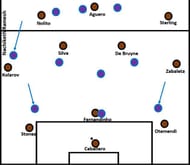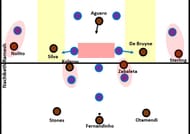Manchester City travelled to Bucharest to face the local side Steaua Bucuresti in the first leg Champions League Qualifying match and beat the home side 5-0 in a thrilling game. The EPL club now awaits the arrival of Bucuresti in the second leg to ensure a spot in the group stages of the tournament. Sergio Aguero with a hat-trick, David Silva, and Nolito featured on the scoresheet.
Teams:
Manchester City: Willy Caballero; Aleksandar Kolarov, John Stones, Nicolas Otamendi, Pablo Zabaleta; Fernandinho; Nolito, David Silva, Kevin de Bruyne, Raheem Sterling; Sergio Aguero.
Steaua Bucuresti: Florin Nita; Marko Momcilovic, Alin Tosca, Gabriel Tamas, Gabriel Enache; Muniru Sulley, Vlad Achim; Jugurtha Hamroun, Nicolae Stanciu, Adrian Popa; Bojan Golubovic.
Pep Guardiola again fielded the team in a 4-1-4-1 formation, the same one that was selected against Sunderland. Laureniu Reghecampf played with a 4-2-3-1 formation.
While Manchester City attacked with possession as the key to open spaces, Reghecampf’s side pressed hard to win the possession from City and attack on the breaks. Against Sunderland, Guardiola’s team experienced high-pressing but never any tough opposition to ball playing the middle third. But against Bucuresti, City found it tough to convert possession into something fruitful as the home team was regularly intercepting and blocking the passes in the early minutes of the game.
Before going over to the in-depth analysis of Manchester City, let us shed some light on how Bucuresti played.
Steaua Bucuresti’s playing style:
You need only watch the first ten minutes of the match to get a decent idea as to how Steaua Bucuresti played. The whole match was just the repetition of what happened in the first 600 seconds. It was a template or blueprint of the match.It’s one thing for Manchester City to stick to their style against a weakling like Steaua and it’s a completely different thing for Steaua to do the same. What is more astonishing is that Bucuresti played in an attacking manner against a lethal side like City.
The players of the home team rarely deviated from the plan. They didn’t worry about the fact that their high-pressing with man-orientations was opening gaps for the visiting team to attack through They weren’t bothered even when Manchester City found a firm footing and started to net in goals in a rather easy fashion. Because Steaua Bucuresti players and coaches were brave. But then bravery is just a sugar-coated word used in place of “stupidity” by the intellectual people of the society to shun their shortcomings.
Bucuresti pressed high since City players were relatively new to the concept of bringing the ball out the defence. The intention was to stifle the attack build-ups and win the ball as close as possible to the visiting side’s goal and it is fair to say that Bucuresti was quite successful in doing so. Manchester City had three or four nervous moments while attack initiations in which the players lost the ball possession to the home team players.
In terms of attacking, Bucuresti applied a direct approach and relied very much on the attacking midfield trio of Hamroun, Stanciu, and Popa. Winning the ball in the middle third and then transitioning quickly in an attempt to target the open spaces was the aim of Bucuresti.
Bucuresti pressed well in the middle third with the help of the use of cover shadows. The attacking midfield trio with the two central midfielders played a crucial part in this. However, man-orientations in its defensive movements and a few man-markings (will be explained in the coming sections) in the middle proved to be the home side’s weak point as Manchester City put five past the goalkeeper to ensure a place in the group stages of the Champions League.
City surprised by Bucuresti’s high-pressing, play to use it against the home team itself.
Manchester City’s goalkeeper Caballero faced some opposition from Bucuresti while building the play from the back. Bucuresti, through Golubovic, Maroun, Stanciu and Popa, put pressure on the first line of attack of Manchester City. While the striker Golubovic was engaging with the dropping defensive midfielder (Fernandinho), the wingers Popa and Maroun pressed the central defenders who spreading wide on both the sides of the goalkeeper.
#10 Stanciu was pressing the space just outside the box. As pointed out in the first section, the intention was to gain something from the mistakes of the opponents due to their minimalistic experience in playing out from the back.
Noticing the man-orientation of the home team players while pressing high, Manchester City started providing triple width – three players of different lines of formation on the wings or the wide regions – usually the ball near side central defender (in the image and GIF – Stones), near side wingback (Kolarov), and near side winger (Nolito, in the image and GIF).
This was dragging the high-pressing Bucuresti players more towards the wings since their movements were dependent on those of the opponents (man-orientation!), creating 3v3 situations on the wings. Then, with good ball playing ability City’s players at the back were able to pick out one of Silva or de Bruyne – both of whom were staying behind the line of pressing of Bucuresti.
Staying behind the line of pressure in order to provide passing outlets and beat the pressing is one of the main tools of positional play practised by Guardiola. This enabled City to beat the home team’s high-pressing, move the ball to a free player behind the pressing line and in front of the defenders and create superiority in the zone ahead of the defenders to attack effectively.
Pressing and ineffective spatial coverage by Bucuresti leads to a lot of vertical passes from City
Without proper covering action leading to an ineffective covering of the space, Bucuresti players had a tough time in dealing with the staggering offered by Manchester City’s shape. For a team playing with a zonal marking system, man-orientations even in the centre of the pitch proved costly as City’s players were flexible and regularly moving in and out of zones.
This was disturbing the focus of Bucuresti players while defending, making them move out of the defensive structure and open spaces. The most glaring mistake was that of the two central midfielders – Sulley and Achim, who were getting dragged wide towards the half-spaces by Silva and De Bruyne, leaving the center open for vertical passes and opponents to move in.
While vertical passes were troubling the already out-of-shape structure of Bucuresti, there was another threat as well – losing compactness in front of the box. With the wide players and near side central midfielder being oriented with the movements of their opponents, the home team was losing horizontal compactness leading to opening of gaps or widening of channels and space creation in front of the defenders.
City players exploit Bucuresti’s poor shape and man-orientation to unlock half-spaces.
There were two ways in which City opened half-spaces during attacks. One was during attacking build-ups and the other one was during attacking progression in the middle third.
- During build-ups: The key to unlocking half-spaces during build-ups was the same as it was against Sunderland. Against Sunderland City’s inverted fullbacks were occupying the wingers and forcing them to be narrow. This was opening space for wingers. Against Bucuresti, albeit they didn’t move central as much as they did against Sunderland, the wingbacks – Kolarov and Zabaleta, were occupying the central space alongside Fernandinho to drag the wingers towards the centre. But unlike Sunderland, Bucuresti’s fullbacks tried to close down the space around the wingers. This unlocked the half-space for Silva and De Bruyne. This (image below) is very similar to the forced structure of Sunderland during the weekend game. The man-orientation and man-marking to a certain level by the central midfielders opened the centre whenever they tried to cover Silva and De Bruyne in the half-spaces.
- During attack progression: During attacking in the attacking half of the pitch, Manchester City exploited Bucuresti’s man-oriented movements by overloading the wings to open near side half-space. With the ball on the wings, Bucuresti was trying to gain numerical superiority in order to stop City’s attacks. This coupled with the man-orientation of the far side central midfielder, was leaving the central region open in front of the central defenders.

Manchester City’s shape and pressing the back pass
This should’ve been discussed earlier. But since the shape of the team was very much similar to that against Sunderland, I’ll only talk about a few specifics that were intriguing. First of all, the top half of the team was exactly the same – Aguero, Nolito, Silva, De Bruyne, and Sterling. Only the roles of Silva and De Bruyne were a bit different. Although they were #10s of the team, they had the freedom to move more towards the wing than in the game against Sunderland. This was mainly because to open the central region for attacks.
Zabaleta played more like an inverted fullback during the attacks in comparison to Kolarov, who was not just limited to the central midfield. He was underlapping Nolito to create overloads on the left side.
City sported a 2-3-4-1ish shape while attacking. A nominal 4-1-4-1 was used in the defensive phase.
With the use of cover shadows to block the passing lanes, City pressed to recover the ball. A detailed article on Manchester City’s pressing under Guardiola will be published in the coming weeks.
Sensing the inability of Bucuresti’s players to build from the back and pass comfortably at the back, Guardiola’s forwards pressed the back pass to put pressure on the ball receiver. While Nolito and Sterling pressed from the sides, De Bruyne and Aguero focused on the center.
Conclusion
In the end, it looked like a comfortable win for Manchester City. Even the final score suggests the same. However, on the pitch, it was slightly different as Steaua Bucuresti posed some serious attacking threat with directness and counter-attacking ability and prevented City;s build-ups in the early stages with some good pressing. Manchester City, with Guardiola bu the side, learned quickly the patterns followed by the opponents to turn the match in their favour in the second half.
We again saw the use, albeit limited, of wingbacks in the central midfield area and the use of Silva and De Bruyne at #10s. Caballero committed a few errors under pressure but showed signs improvement. It might not be enough as he might soon be replaced by Claudio Bravo of Barcelona.
On Saturday, Manchester City will play Stoke City. Watch this space for the analysis of that match in the next episode of PEP TALK.




